Travel News
Will Virgin Galactic Take Off This Year?
This past Tuesday, Virgin Galactic’s SpaceShip Two broke the sound barrier during a test flight in the Mojave Desert. Since 2004, Virgin Galactic has been working with different types of aircraft to make strides in space tourism. After this first successful powered space flight, the company thinks commercial service is not too far behind.
The idea of space tourism began with MirCorp in the 1990s, when the company decided to offer visits to the Mir space station to offset costs. Since then, the Russian Space Agency and privately owned companies have offered to take paying passengers into suborbital spaceflight. This means that while they’re in space, they’re not far from Earth, just close enough to see the planet from the same position as a satellite.
Never one to back down from an ambitious endeavor, Virgin Group has created Virgin Galactic. Over the past eight and a half years, the company has been building new forms of aircraft and defining a passenger program.
The Spacecraft
 Unlike the NASA spaceships we’re all familiar with that had huge takeoffs from the ground, SpaceShip Two (SS2) will launch horizontally from about 50,000 feet above the Earth. SS2 will take off attached to the Virgin MotherShip Eve (VMS Eve), a double-fuselage plane with a 140 foot wingspan. The ship has a hybrid rocket motor, which only needs to burn for a short period of time to reach space from that height.
Unlike the NASA spaceships we’re all familiar with that had huge takeoffs from the ground, SpaceShip Two (SS2) will launch horizontally from about 50,000 feet above the Earth. SS2 will take off attached to the Virgin MotherShip Eve (VMS Eve), a double-fuselage plane with a 140 foot wingspan. The ship has a hybrid rocket motor, which only needs to burn for a short period of time to reach space from that height.
Named after Sir Richard Branson’s mother, the fuselages of VMS Eve are identical to that of SS2. Both are made from carbon composite, making them durable but lightweight. VMS Eve can also carry up to 35,000 pounds while flying up to 50,000 feet high and over 2,000 nautical miles. Since it can perform zero gravity maneuvers, it will likely be used to train passengers before they enter into space. SS2 is about 60 feet long with a cabin 90 inches (7.5 feet) in diameter, and carries two pilots and six passengers.
 Both ships were designed by aerospace engineer Burt Rutan of Scaled Composites. The design of SS2 is modeled after the shuttlecock, and the ship can perform what is known as a feathered reentry. One of the greatest dangers on spaceships has been reentry into the Earth’s atmosphere; often the ships fall too quickly while getting very hot and require extra equipment to stay cool and slow down.
Both ships were designed by aerospace engineer Burt Rutan of Scaled Composites. The design of SS2 is modeled after the shuttlecock, and the ship can perform what is known as a feathered reentry. One of the greatest dangers on spaceships has been reentry into the Earth’s atmosphere; often the ships fall too quickly while getting very hot and require extra equipment to stay cool and slow down.
Since SS2 is made of strong, lightweight materials, it does not get nearly as heated when it reenters the atmosphere. When it descends to 70,000 feet, SS2 becomes a glider by creating high drag at a low weight and glides back to the runway. If there are any problems during takeoff after the SS2 has detached from VMS Eve, it can do the same. Its wings allow the ship to turn at an angle in the air, and has the capacity for the pilot to reenter hands-free.
Spaceport America
 The space tourism industry will shortly have its own spaceport, and it’s not at Cape Canaveral. It’s near Las Cruces, New Mexico, a state that gets 350 days of sunlight a year. Since the 1960s, politicians have been trying to draw attention to New Mexico as the ideal place to conduct space takeoffs. Since the spot is isolated and has clear skies for the greater part of the year, the local impact will be minimal and weather problems will be slight.
The space tourism industry will shortly have its own spaceport, and it’s not at Cape Canaveral. It’s near Las Cruces, New Mexico, a state that gets 350 days of sunlight a year. Since the 1960s, politicians have been trying to draw attention to New Mexico as the ideal place to conduct space takeoffs. Since the spot is isolated and has clear skies for the greater part of the year, the local impact will be minimal and weather problems will be slight.
This project has been running since the early 1990s, and the state of New Mexico has put up $200 million to build Spaceport America. When finished, it will consist of 27 square miles. New Mexico politicians are optimistic about the creation of jobs, and tours of the site are currently available.
On December 31, 2008, Virgin Galactic signed a 20 year lease with Spaceport America, agreeing to make it their headquarters and base of operations. Since the spaceport is still under construction, Galactic has been running their tests in the Mojave Desert. But they’re only one of four companies: UP Aerospace, Armadillo Aerospace, and Lockheed Martin are also tenants of the spaceport.
In the Future
 So far, about 570 people have made deposits for seats on SS2. This number is only slightly higher than the amount of people who have ever been to space. Each ticket is about $200,000 and refundable deposits start around $20,000. With deposits coming in since 2005, the total amount Virgin Galactic has received thus far is over $70 million.
So far, about 570 people have made deposits for seats on SS2. This number is only slightly higher than the amount of people who have ever been to space. Each ticket is about $200,000 and refundable deposits start around $20,000. With deposits coming in since 2005, the total amount Virgin Galactic has received thus far is over $70 million.
Tuesday’s test that broke the sound barrier was Virgin Galactic’s first powered space flight, and more are expected to come throughout the year. The first space flight might be as early as next year, after which commercial service should follow.
Even though it may be a while until this happens, Virgin Galactic has already begun to design its training program. After having a medical examination, passengers will go through three days of training, which includes some practice flying at zero gravity in VMS Eve.
As of now, SS2 will only reach high enough so that the six passengers will be able to see the curvature of the Earth, although constellations such as the Milky Way will also be visible. The fuselage of SS2 will have windows above and beside seats, and once it has reached its highest point, passengers can stay seated, float about the cabin, or do “astrobatics.”
But it will still be a while before Virgin Galactic gets out of the Earth’s atmosphere. While the future will see more and more test flights, it’s also possible for unseen problems to come up.
By Stephanie Ervin for PeterGreenberg.com












